Bitcoin Magazine Pro
Bitcoin’s Anticipated Retail Resurgence
Published
4 months agoon
By
admin
Bitcoin’s recent price action has been a rollercoaster of highs and lows. However, even though bitcoin has set a new all-time high and had two years of a near-constant positive trajectory, we’re yet to see a consistent influx of retail investors. The potential for a surge in retail participation and the possibility of elevating the bitcoin price to unprecedented levels are prospects that many investors are anxiously anticipating. In this article, we’re going to explore when we might see these retail investors dive back into the bitcoin pool and whether their return could indeed propel BTC to even greater heights.

Active Address Growth and its Impact
To anticipate this potential retail wave, it’s important to scrutinize the trend of active address growth. Data sourced from Bitcoin Magazine Pro suggests a downward swing in the number of active network participants in recent months. The 365-day moving average (blue line), along with the 60-day (purple line) and 30-day averages (red line), tell a tale of decreased network activity. This drop takes the count of active users back to levels reminiscent of early 2019, following bitcoin’s bear cycle, when prices hovered between $3,500 to $4,000.
This decline in active network users raises eyebrows about bitcoin’s upside potential in the current cycle. Interestingly, despite bitcoin hitting a new record of roughly $74,000, there was no corresponding sustained uptick in network users, a stark departure from previous cycles.
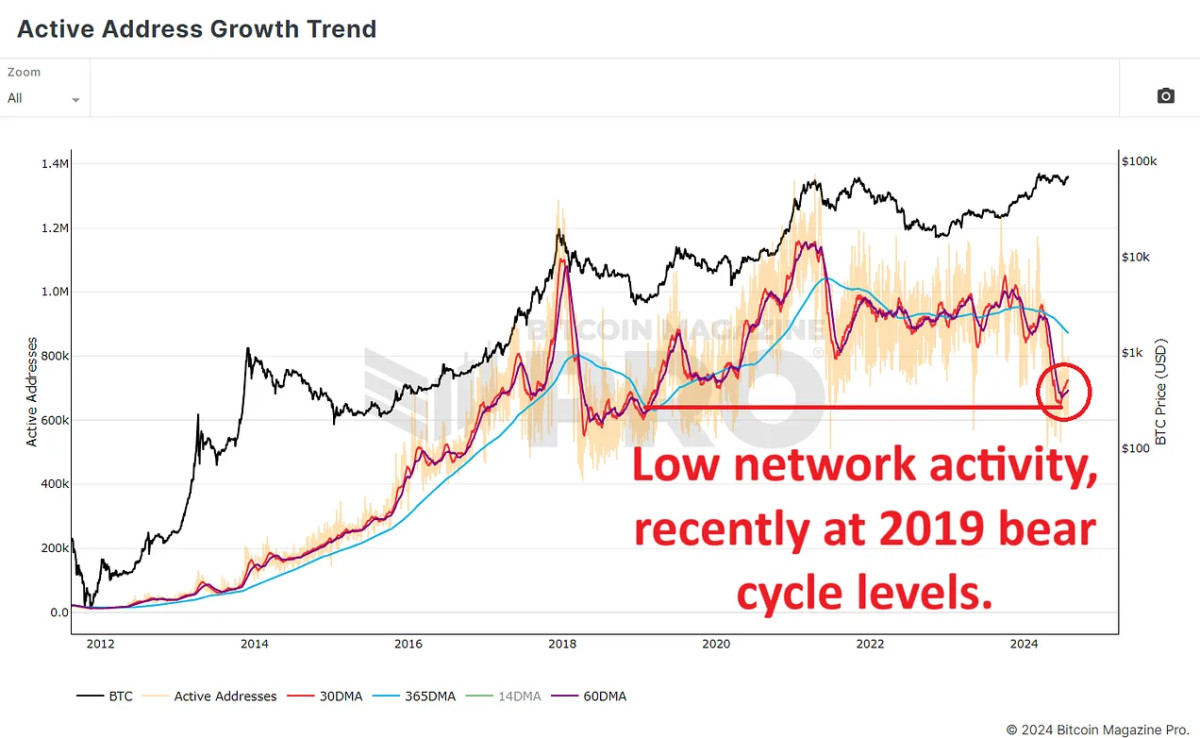
The Necessary Inflow of New Capital
This trend could be a reflection of Bitcoin’s evolving identity. Originally a digital peer-to-peer currency, Bitcoin is increasingly seen as a store of value. As a result, fewer people are using it for everyday transactions and are instead pouring capital into bitcoin as a long-term asset.
The Bitcoin HODL Waves & Realized Cap HODL Waves shed light on this shift. These metrics group Bitcoin network users based on the duration they’ve held their coins, as well as showing their influence on the accumulation price of BTC. Recent data reveals that about 20% of bitcoin has been held for three months or less, indicating that new users are entering the market, but as we can see from the average active addresses in the above data, not using Bitcoin as frequently as before.
The impact of these new users on the realized cap (the average accumulation price of all BTC) is considerable, with over 40% of recent influence coming from users holding Bitcoin for three months or less (indicated by the warmer red/orange colors in the chart below). This suggests that users are entering the market at higher prices and are behaving in a manner consistent with previous cycles (we’re recently seen the initial early bull cycle inflows at comparable levels to previous cycles, indicated by the red box), just not as frequently as we have previously seen.
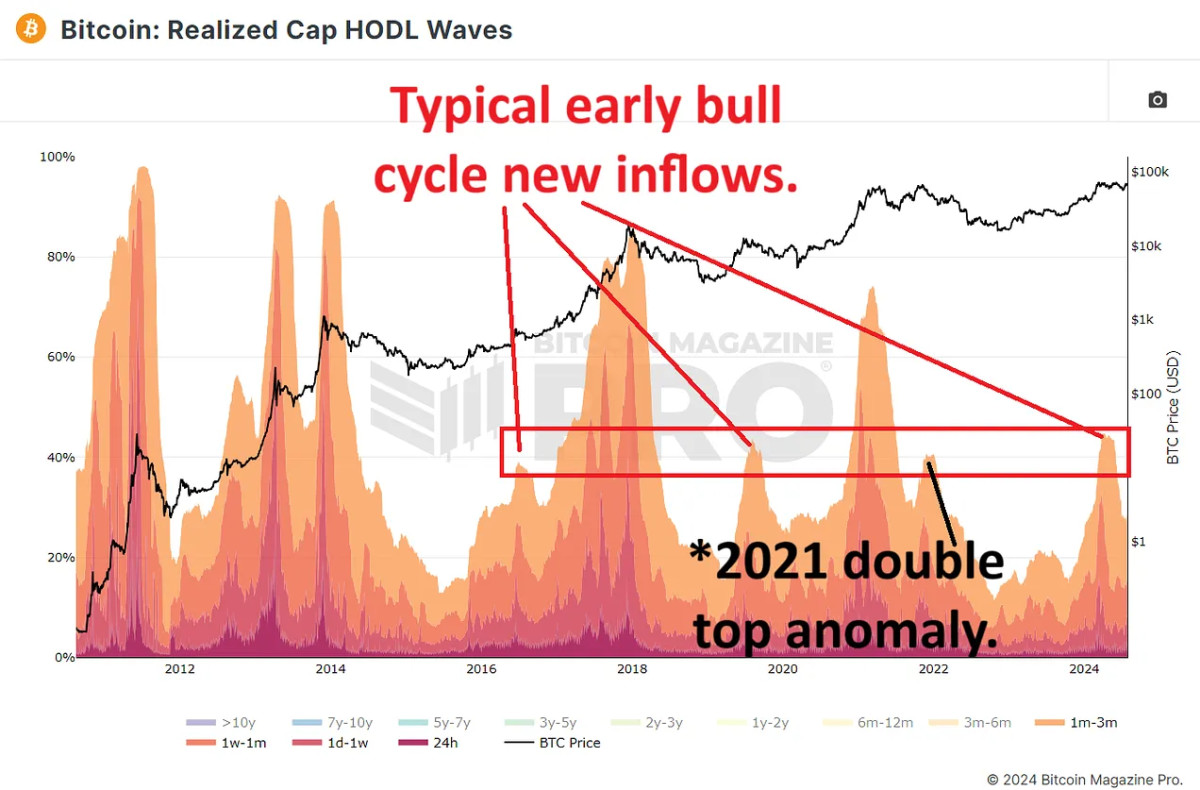
Understanding Market Forces and Retail Involvement
A look at Bitcoin’s past cycles shows that a surge in retail activity often precedes market peaks. For example, in the 2017 and 2021 bull runs, retail interest spiked around 6 months before the price peaks. The current absence of a significant increase in retail interest, as evidenced by Google Trends, suggests we’re experiencing a more measured, and more sustainable market growth.
Another key consideration is the Bitcoin Open Interest chart, which measures the total value of open bitcoin futures contracts. Since late 2022, this metric hasn’t shown a significant increase; in fact, we’ve seen a steady decline since the bear cycle lows (indicated by the declining red line in the chart below). Revealing that investors are now preferring to trade actual bitcoin rather than merely participating in derivatives trading. This indicates a shift in narrative where investors are more interested in holding bitcoin for the long haul rather than chasing short-term speculative gains.
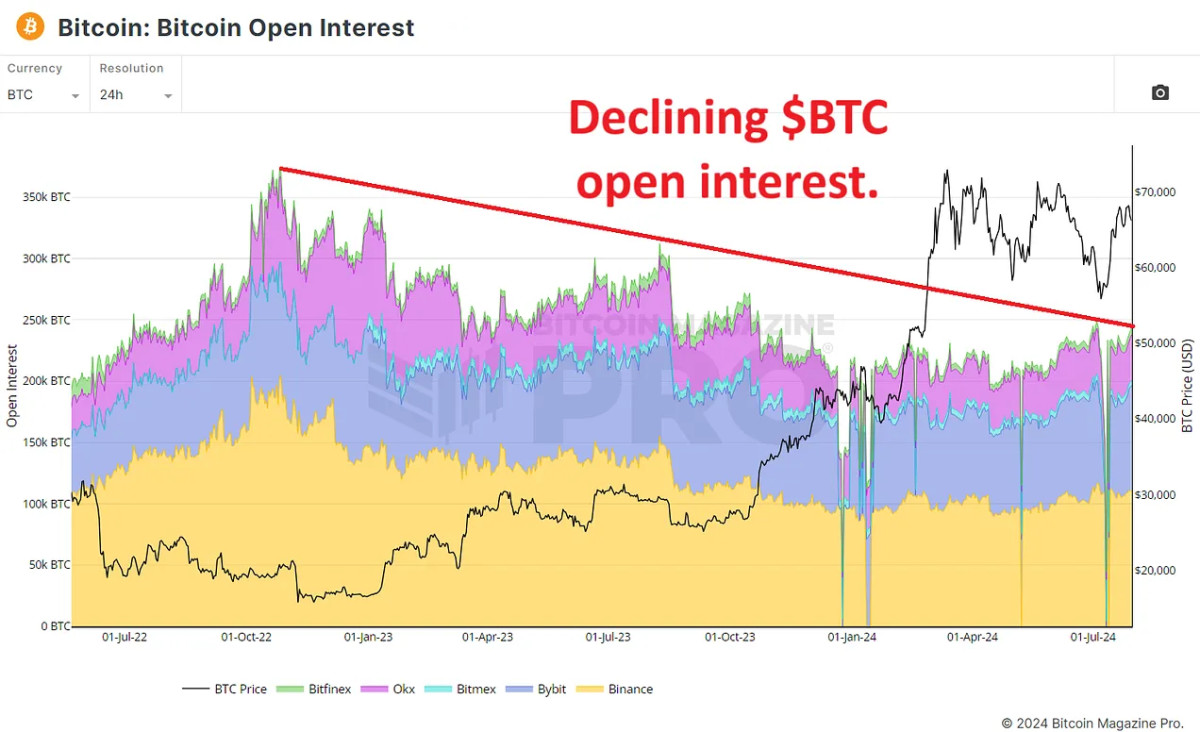
Conclusion
Given current trends, the lack of a retail frenzy could be seen as a positive sign for the market’s long-term prospects. As bitcoin approaches new record highs, keeping a close eye on the arrival of retail investors will be essential. If retail investors start entering the market in large numbers, will they fall back into old habits of pure FOMO buying, or will they continue to favor long-term holding?
In short, despite a fall in Bitcoin’s active user metrics, the market shows signs of stability and long-term investment. The absence of immediate retail interest might seem bearish, but it’s more likely to be bullish as it indicates a more measured and sustainable growth trajectory.
For a more in-depth look into this topic, check out a recent YouTube video here:
Source link
You may like


Top crypto traders’ picks for explosive growth by 2025


3 Tokens Ready to 100x After XRP ETF Gets Approval


Gary Gensler’s Departure Is No Triumph For Bitcoin


Magic Eden Token Airdrop Date Set as Pre-Market Value Hits $562 Million


Blockchain Association urges Trump to prioritize crypto during first 100 days


Pi Network Coin Price Surges As Key Deadline Nears
Bitcoin Magazine Pro
The Bitcoin Pi Cycle Top Indicator: How to Accurately Time Market Cycle Peaks
Published
11 hours agoon
November 22, 2024By
admin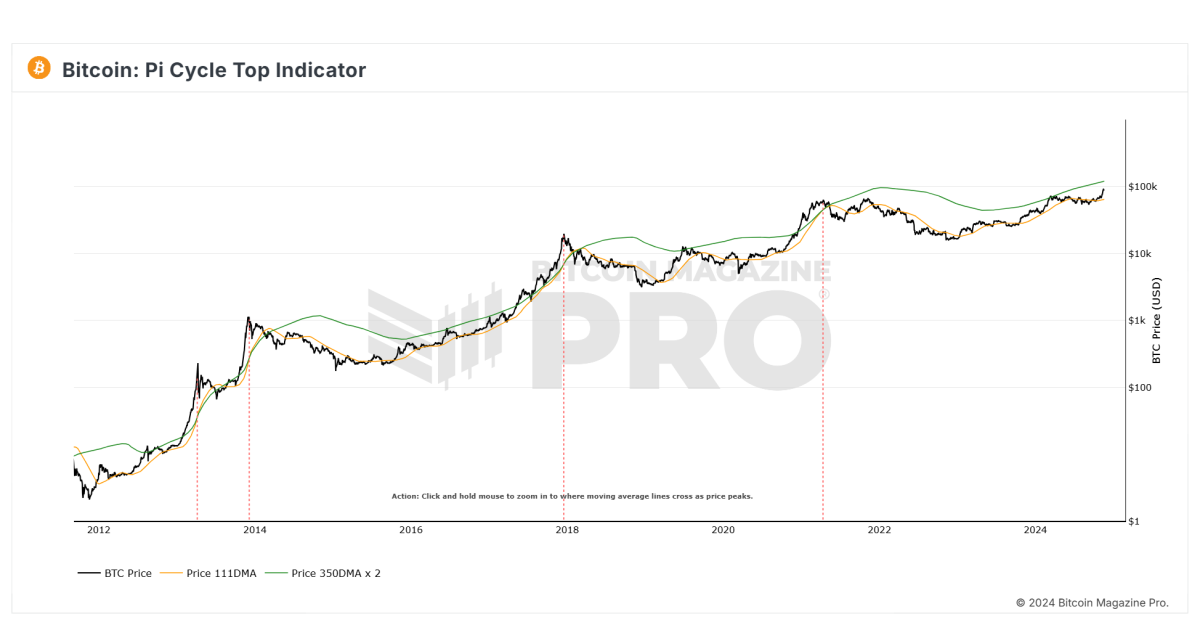
The Bitcoin Pi Cycle Top Indicator has gained legendary status in the Bitcoin community for its uncanny accuracy in identifying market cycle peaks. Historically, it has timed every single Bitcoin cycle high with remarkable precision—often within just three days. Could it work its magic again this cycle? Let’s dive deeper into how it works and its significance in navigating Bitcoin’s market cycles.
What is the Pi Cycle Top Indicator?
The Pi Cycle Top Indicator is a tool designed to identify Bitcoin’s market cycle tops. Created by Philip Swift, Managing Director of Bitcoin Magazine Pro in April 2019, this indicator uses a combination of two moving averages to forecast cycle highs:
- 111-Day Moving Average (111DMA): Represents the shorter-term price trend.
- 350-Day Moving Average x 2 (350DMA x 2): A multiple of the 350DMA, which captures longer-term trends.
When the 111DMA rises sharply and crosses above the 350DMA x 2, it historically coincides with Bitcoin’s market cycle peak.
The Mathematics Behind the Name
Interestingly, the ratio of 350 to 111 equals approximately 3.153—remarkably close to Pi (3.142). This mathematical quirk gives the indicator its name and highlights the cyclical nature of Bitcoin’s price action over time.
Why Has It Been So Accurate?
The Pi Cycle Top Indicator has been effective in predicting the peaks of Bitcoin’s three most recent market cycles. Its ability to pinpoint the absolute tops reflects Bitcoin’s historically predictable cycles during its adoption growth phase. The indicator essentially captures the point where the market becomes overheated, as reflected by the steep rise of the 111DMA surpassing the 350DMA x 2.
How Can Investors Use This Indicator?
For investors, the Pi Cycle Top Indicator serves as a warning sign that the market may be approaching unsustainable levels. Historically, when the indicator flashes, it has been advantageous to sell Bitcoin near the top of the market cycle. This makes it a valuable tool for those seeking to maximize gains and minimize losses.
However, as Bitcoin matures and integrates further into the global financial system—bolstered by developments like Bitcoin ETFs and institutional adoption—the effectiveness of this indicator may diminish. It remains most relevant during Bitcoin’s early adoption phase.
A Glimpse Into the Future
The big question now is: will the Pi Cycle Top Indicator remain accurate in this cycle? With Bitcoin entering a new era of adoption and market dynamics, its cyclical patterns may evolve. Yet, this tool has proven its worth repeatedly over Bitcoin’s first 15 years, offering investors a reliable gauge of market tops.
Final Thoughts
The Pi Cycle Top Indicator is a testament to Bitcoin’s cyclical nature and the power of mathematical models in understanding its price behavior. While its past accuracy has been unparalleled, only time will tell if it can once again predict Bitcoin’s next market cycle peak. For now, it remains an indispensable tool for those navigating the thrilling highs and lows of Bitcoin.
Explore the full chart and stay informed.
Source link
Bitcoin Magazine Pro
Are Retail Investors Behind The Bitcoin Price Surge This Bull Run?
Published
6 days agoon
November 16, 2024By
admin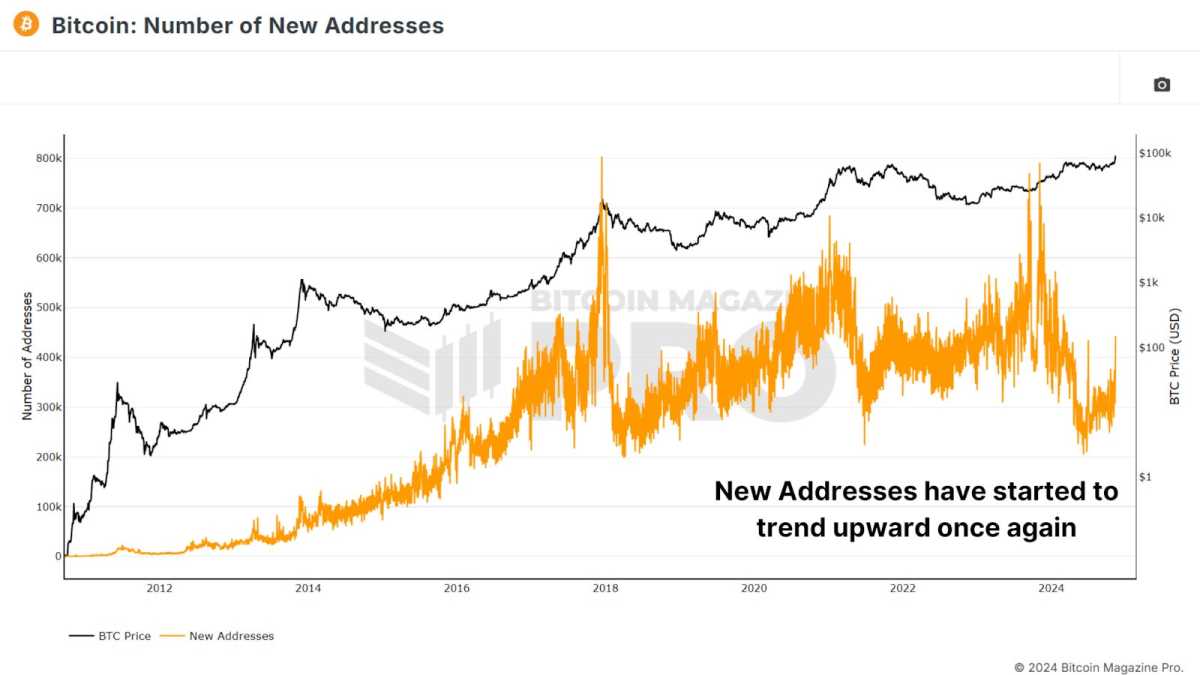
As Bitcoin once again finds itself in price discovery mode, market watchers and enthusiasts are curious: has retail FOMO set in yet, or is the retail surge we’ve seen in past bull cycles still on the horizon? Using data from active addresses, historical cycles, and various market indicators, we’ll examine where the Bitcoin market currently stands and what it might signal about the near future.
Rising Interest
One of the most direct signs of retail interest is the number of new Bitcoin addresses created. Historically, sharp increases in new addresses have often marked the beginning of a bull run as new retail investors flood into the market. In recent months, however, the growth in new addresses hasn’t been as sharp as one might expect. Last year, we saw around 791,000 new addresses created in a single day—a sign of considerable retail interest. In comparison, we now hover significantly lower, although we have recently seen a modest uptick in new addresses.

Google Trends also reflects this tempered interest. Although searches for “Bitcoin” have been increasing in the past month, they remain far below previous peaks in 2021 and 2017. It seems that retail investors are showing a renewed curiosity but not yet the fervent excitement typical of FOMO-driven markets.
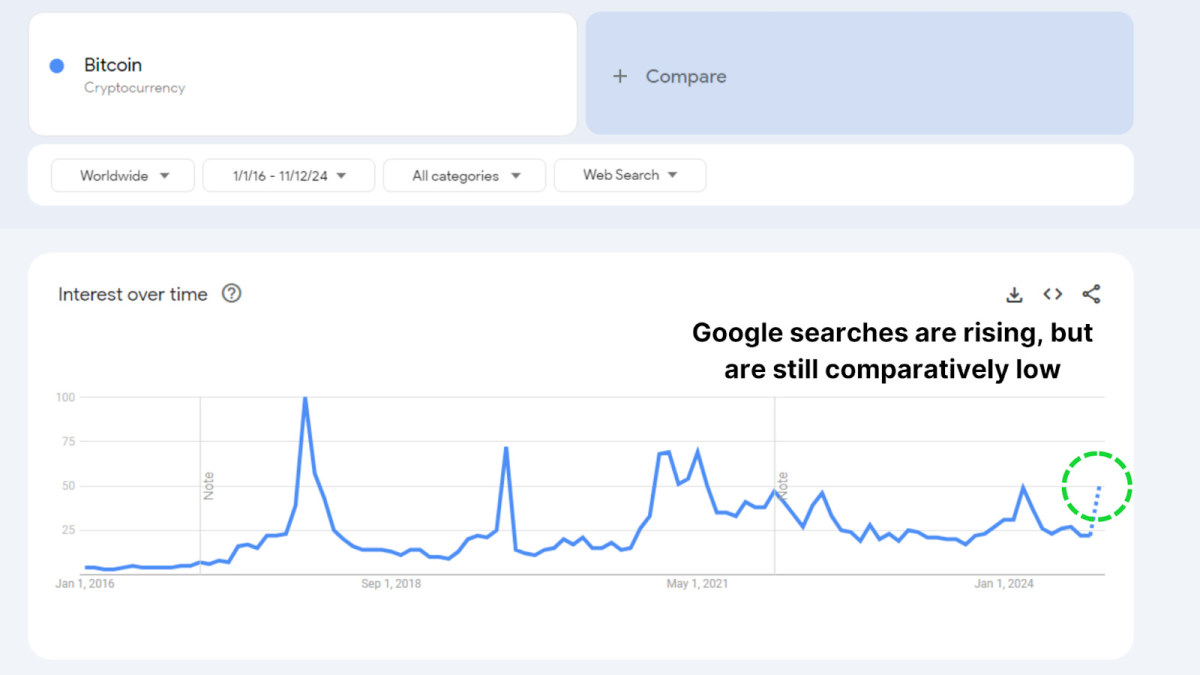
Supply Shift
We are witnessing a slight transition of Bitcoin from long-term holders to newer, shorter-term holders. This shift in supply can hint at the potential start of a new market phase, where experienced holders begin taking profits and selling to newer market participants. However, the overall number of coins transferred remains relatively low, indicating that long-term holders aren’t yet parting with their Bitcoin in significant volumes.
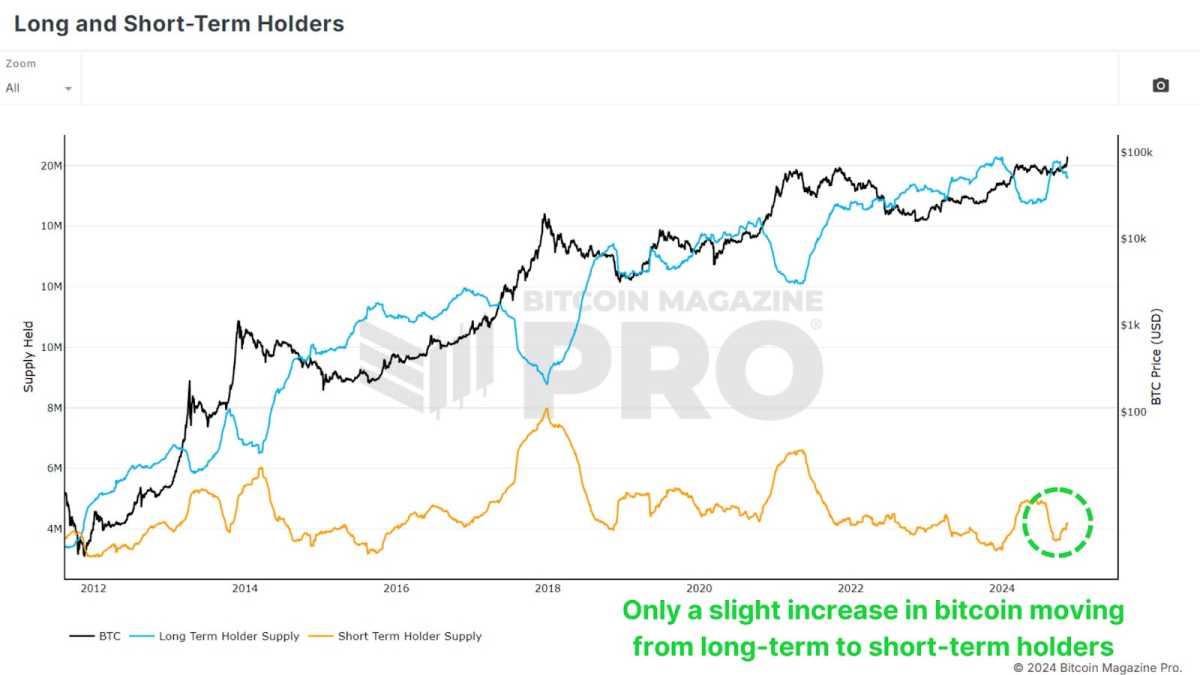
Historically, during the last bull run in 2020-2021, we saw large outflows from long-term holders to newer investors, which fueled a subsequent price rally. Currently, the shift is only minor, and long-term holders seem largely unfazed by current price levels, opting to hold onto their Bitcoin despite market gains. This reluctance to sell suggests that holders are confident in further upside potential.
A Spot-Driven Rally
A key aspect of Bitcoin’s latest rally is its spot-driven nature, in contrast to previous bull runs heavily fueled by leveraged positions. Open interest in Bitcoin derivatives has seen only minor increases, which stands in sharp contrast to prior peaks. For instance, open interest was significant before the FTX crash in 2022. A spot-driven market, without excessive leverage, tends to be more stable and resilient, as fewer investors are at risk of forced liquidation.
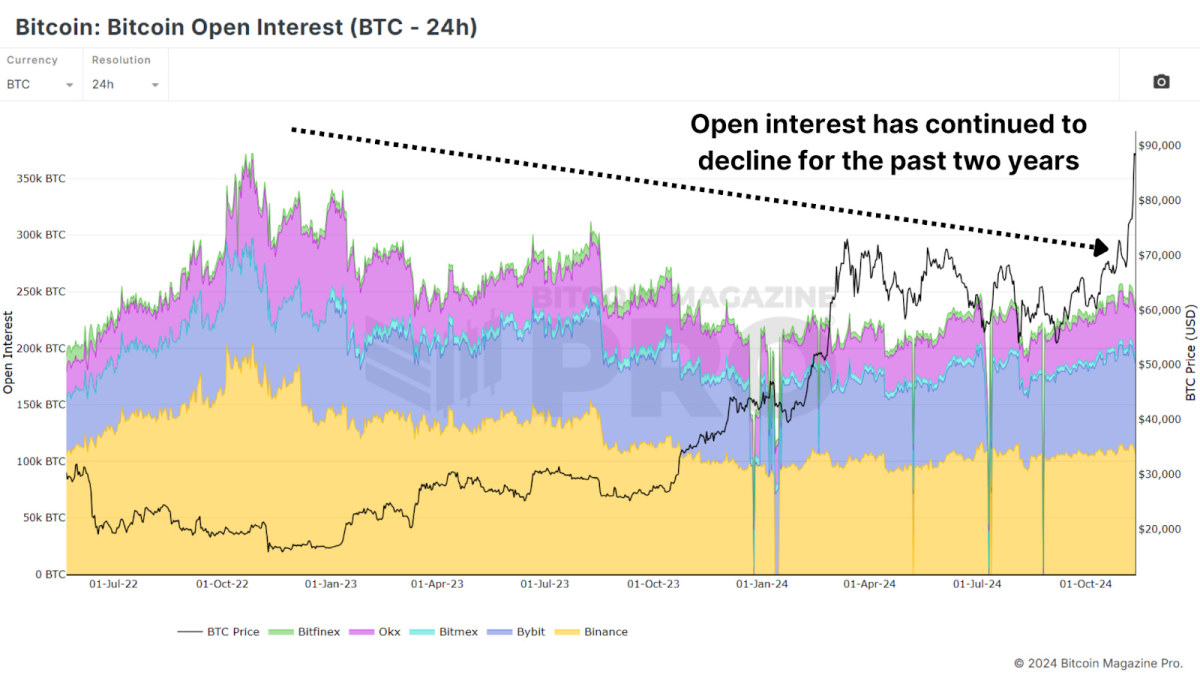
Big Holders Accumulating
Interestingly, while retail addresses haven’t increased substantially, “whale” addresses holding at least 100 BTC have been rising. Over the past few weeks, wallets with large BTC holdings have added tens of thousands of coins, amounting to billions of dollars in value. This increase signals confidence among Bitcoin’s largest investors that the current price levels have more room to grow, even as Bitcoin reaches all-time highs.
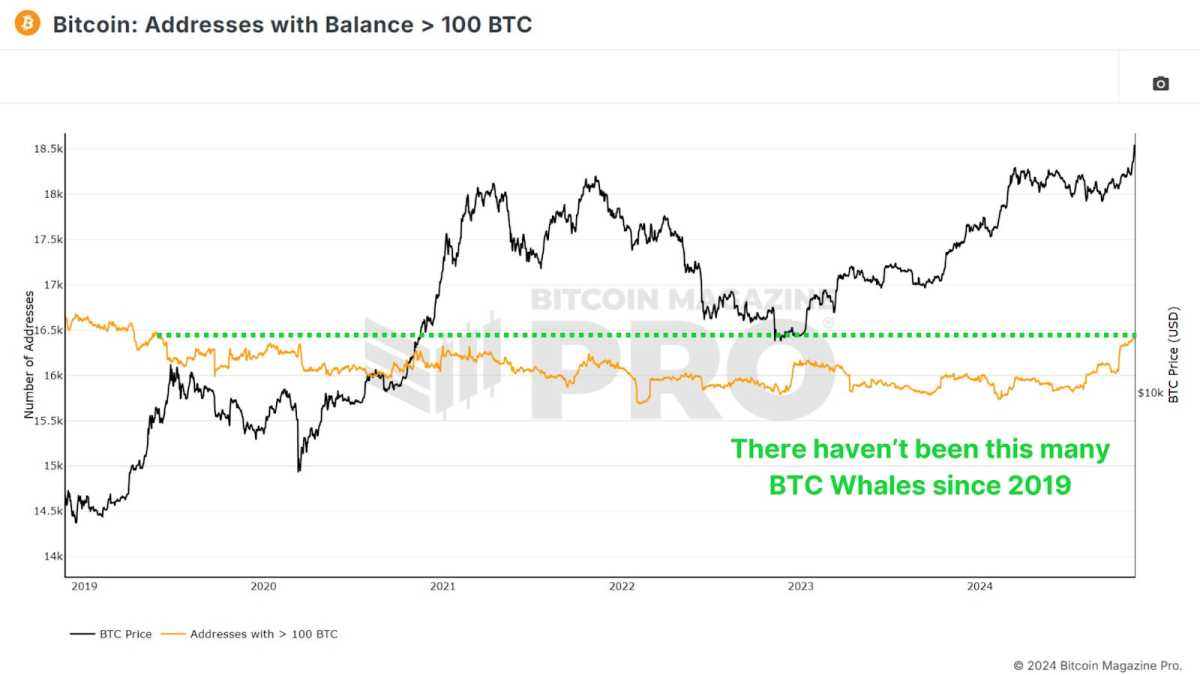
In past bull cycles, we saw whales exit or decrease their positions near market peaks, a behavior we’re not seeing this time. This trend of accumulation by experienced holders is a strong bullish indicator, as it suggests faith in the market’s long-term potential.
Conclusion
While Bitcoin’s rally to all-time highs has brought renewed attention, we’re not yet seeing the telltale signs of widespread retail FOMO. The subdued retail interest suggests we may be only in the beginning phase of this rally. Long-term holders remain confident, whales are accumulating, and leverage remains modest, all indicators of a healthy, sustainable rally.
As we continue into this bull cycle, the market’s structure suggests that the potential for a larger retail-driven surge remains ahead. If this retail interest materializes, it could propel Bitcoin to new heights.
For a more in-depth look into this topic, check out a recent YouTube video here: Has Retail Bitcoin FOMO Begun?
Source link
Bitcoin Magazine Pro
The Truth About Bitcoin Price Models: Stock-to-Flow, Power Law, and Beyond
Published
1 week agoon
November 13, 2024By
admin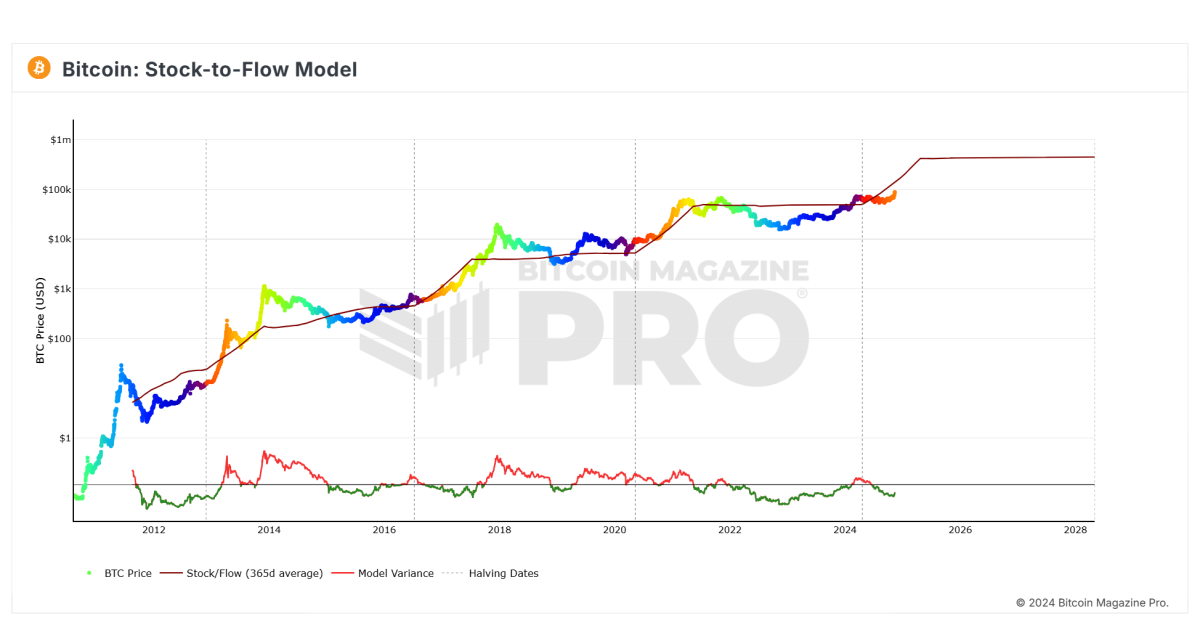
Predicting Bitcoin’s price has always been a hot topic for investors. Matt Crosby, lead market analyst at Bitcoin Magazine Pro, explores this topic in his recent video, “Truth About Bitcoin Stock To Flow, Power Law & Price Models“. Here, we break down Crosby’s key insights to help investors enhance their Bitcoin strategies.
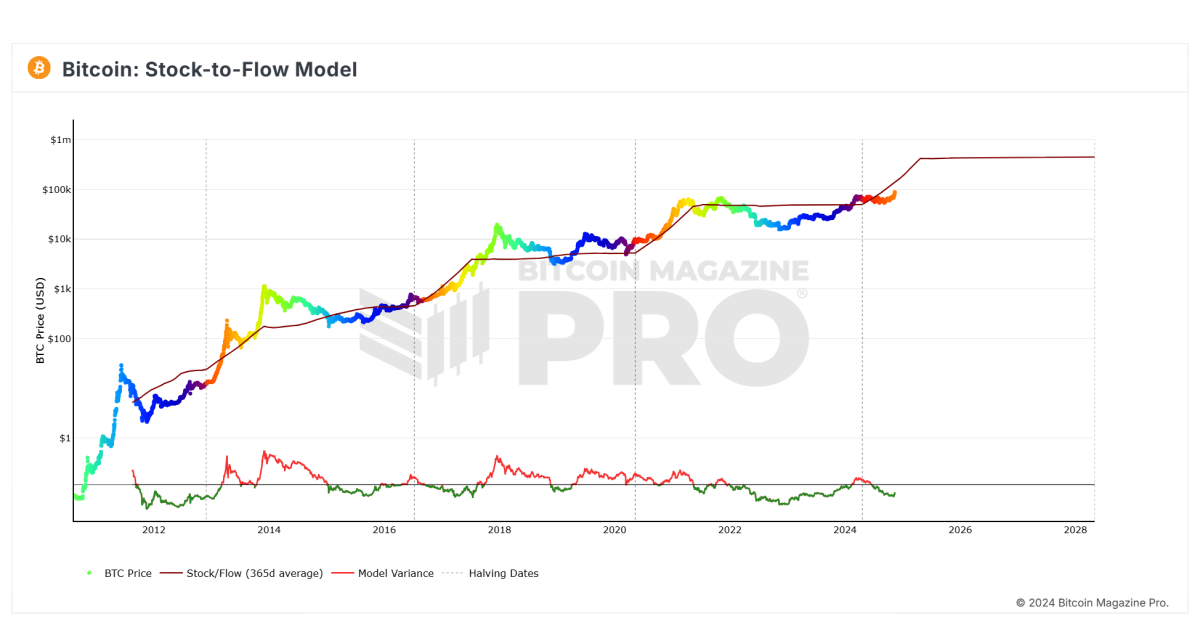
Stock-to-Flow (S2F): A Useful Tool, Not a Crystal Ball
The Stock-to-Flow (S2F) model is one of the most popular ways to predict Bitcoin prices, and Crosby explains its benefits and drawbacks clearly.
Key Takeaways:
- What Is S2F? S2F assesses Bitcoin’s scarcity by comparing the “stock” (current supply) to the “flow” (newly mined coins), similar to how rare commodities like gold are evaluated.
- Updated Predictions: The Cross-Asset S2F model initially forecasted Bitcoin hitting $288,000 between 2020 and 2024. More recently, it suggested a possible valuation of $420,000 by April 2025.
- Limitations: S2F works until unexpected events—like global economic changes—disrupt Bitcoin’s usual patterns. Crosby aptly points out, “S2F works until it doesn’t.”
While S2F is a helpful guide, it’s essential for investors to consider broader market conditions and macroeconomic influences alongside it.
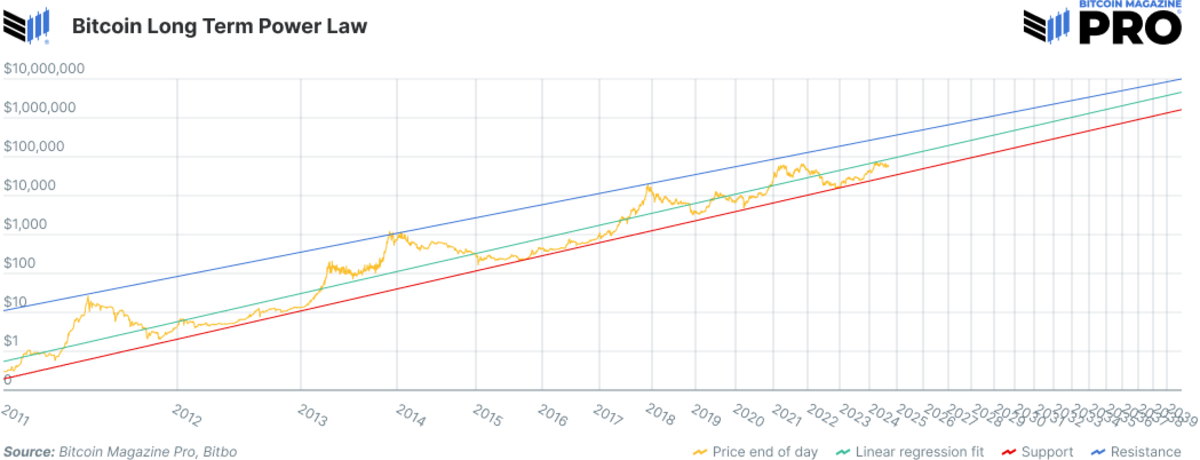
Bitcoin Power Law: The Long-Term View
Crosby also explores the Bitcoin Power Law, a model that uses a log-log chart to illustrate Bitcoin’s historical price patterns.
Why It Matters:
- Logarithmic Scaling: By using logarithmic scaling, the Power Law highlights Bitcoin’s long-term trend of reduced volatility and moderated growth.
- Limitations: This model offers insights for the long haul but is less helpful for short-term predictions or market surprises.
For investors aiming to diversify their portfolios and strategically time their investments, the Power Law provides context but should be used with other, more dynamic tools.
Real-Time Metrics: The Key to Adaptability
Crosby emphasizes the limits of static models like S2F and the Power Law, advocating for real-time, data-driven approaches instead.
Tools Investors Should Use:
- MVRV Z-Score: Measures market cap against realized cap, identifying when Bitcoin is overvalued or undervalued.
- SOPR (Spent Output Profit Ratio): Provides insights into market sentiment by tracking profit-taking behavior.
- On-Chain Metrics: Metrics like Bitcoin’s realized price and value-days-destroyed help detect market turning points.
These metrics give investors the tools to adapt their strategies to the market’s behavior in real-time rather than relying solely on predictions.
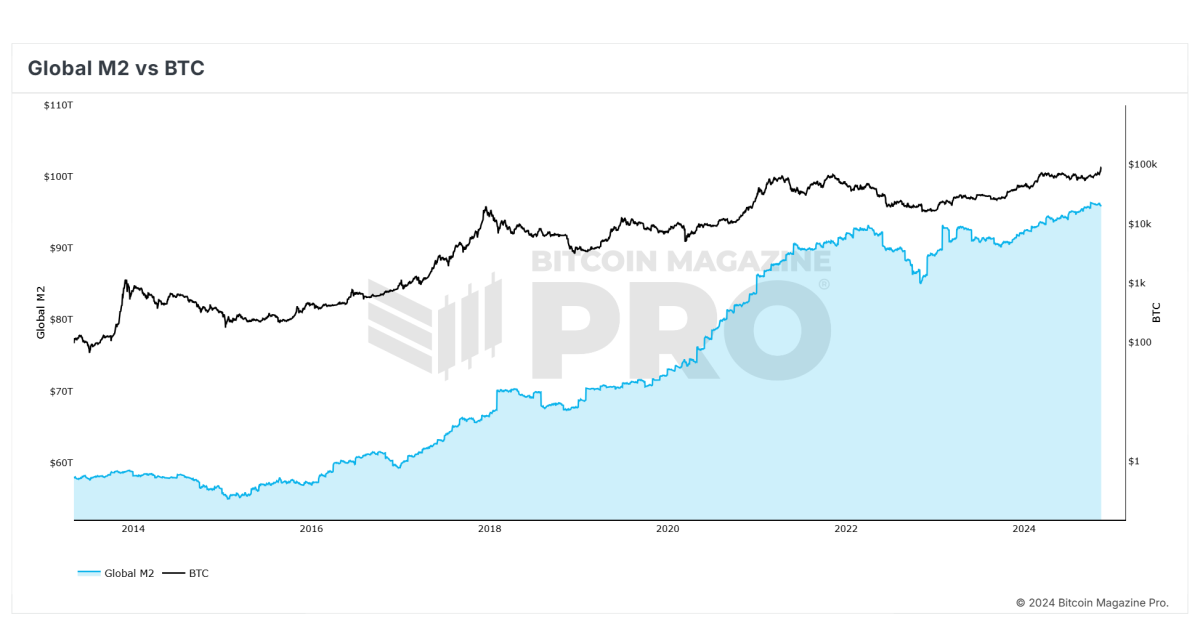
Why External Factors Matter
Crosby cautions against relying only on Bitcoin-specific data, emphasizing the importance of external factors:
- Global Liquidity: Bitcoin’s price often moves with global liquidity cycles, making macroeconomic awareness crucial.
- Institutional Adoption: Actions by major players such as sovereign wealth funds, corporate treasuries, or institutional asset managers can greatly influence Bitcoin’s price.
- Regulatory Changes: Government decisions to regulate or adopt Bitcoin can significantly affect its valuation.
Incorporating both macroeconomic factors and Bitcoin-specific metrics is key for a well-rounded analysis.
Final Thoughts: Stay Pragmatic
Crosby concludes by reminding investors that no single model can predict Bitcoin’s price with certainty. Instead, these tools should be used to provide structure and insight into an unpredictable asset.
Practical Tips for Investors:
- Use Multiple Models: Cross-check predictions using different models to gain a clearer understanding of the market.
- Embrace Real-Time Data: Rely on metrics like MVRV Z-score and SOPR for timely, actionable insights.
- Adapt to Change: Be ready to adjust strategies based on both internal data and external influences.
Bitcoin Magazine Pro offers advanced analytics and real-time data to help investors navigate this fast-paced market. To dive deeper into Crosby’s insights, watch the full video here: Truth About Bitcoin Stock To Flow, Power Law & Price Models.
Source link

Top crypto traders’ picks for explosive growth by 2025

3 Tokens Ready to 100x After XRP ETF Gets Approval

Gary Gensler’s Departure Is No Triumph For Bitcoin

Magic Eden Token Airdrop Date Set as Pre-Market Value Hits $562 Million

Blockchain Association urges Trump to prioritize crypto during first 100 days

Pi Network Coin Price Surges As Key Deadline Nears

How Viable Are BitVM Based Pegs?

UK Government to Draft a Regulatory Framework for Crypto, Stablecoins, Staking in Early 2025

Bitcoin Cash eyes 18% rally

Rare Shiba Inu Price Patterns Hint SHIB Could Double Soon

The Bitcoin Pi Cycle Top Indicator: How to Accurately Time Market Cycle Peaks
Bitcoin Breakout At $93,257 Barrier Fuels Bullish Optimism

Bitcoin Approaches $100K; Retail Investors Stay Steady

Solana Hits New ATH On Huge Whale Accumulation, More Gains Ahead?

Microsoft Should Buy $78 Billion Worth of Bitcoin
182267361726451435

Top Crypto News Headlines of The Week

Why Did Trump Change His Mind on Bitcoin?

New U.S. president must bring clarity to crypto regulation, analyst says

Ethereum, Solana touch key levels as Bitcoin spikes

Bitcoin Open-Source Development Takes The Stage In Nashville

Will XRP Price Defend $0.5 Support If SEC Decides to Appeal?

Bitcoin 20% Surge In 3 Weeks Teases Record-Breaking Potential

Ethereum Crash A Buying Opportunity? This Whale Thinks So

Shiba Inu Price Slips 4% as 3500% Burn Rate Surge Fails to Halt Correction

‘Hamster Kombat’ Airdrop Delayed as Pre-Market Trading for Telegram Game Expands

Washington financial watchdog warns of scam involving fake crypto ‘professors’

Citigroup Executive Steps Down To Explore Crypto
Mostbet Güvenilir Mi – Casino Bonus 2024

Bitcoin flashes indicator that often precedes higher prices: CryptoQuant
Trending

 2 months ago
2 months ago182267361726451435

 24/7 Cryptocurrency News3 months ago
24/7 Cryptocurrency News3 months agoTop Crypto News Headlines of The Week

 Donald Trump4 months ago
Donald Trump4 months agoWhy Did Trump Change His Mind on Bitcoin?

 News3 months ago
News3 months agoNew U.S. president must bring clarity to crypto regulation, analyst says

 Bitcoin4 months ago
Bitcoin4 months agoEthereum, Solana touch key levels as Bitcoin spikes

 Opinion4 months ago
Opinion4 months agoBitcoin Open-Source Development Takes The Stage In Nashville

 Price analysis3 months ago
Price analysis3 months agoWill XRP Price Defend $0.5 Support If SEC Decides to Appeal?

 Bitcoin4 months ago
Bitcoin4 months agoBitcoin 20% Surge In 3 Weeks Teases Record-Breaking Potential



